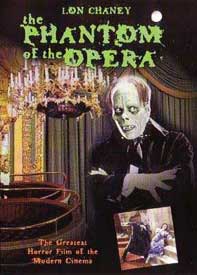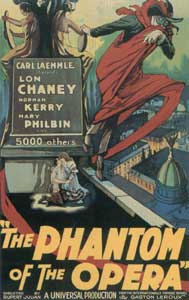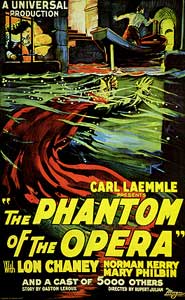Gloomily shadowed Paris sewers immediately set a mood of horror in the silent film Phantom of the Opera (1925). Cellars & long forgotten dungeons provide stark contrasts of sets to the bright interiors of the Paris Opera.
 There's more back-stage humor than many might expect of the horror tale, & the varied sets are the highlight of the film, even more than Lon Chaney's famous make-up. There's more back-stage humor than many might expect of the horror tale, & the varied sets are the highlight of the film, even more than Lon Chaney's famous make-up.
The Phantom wants Carlotta (Virginia Pearson) out of the Opera so that his favorite Christine (Mary Philbin) can be the starring diva. His behind-the-walls machinations to achieve this end informs much of the synoptically told tale up to the point of the Phantom causing the chandelier catastrophe. For the longest while we see the Phantom only as a shadow.
The Phantom's motivation seems inexplicably changed after the chandelier incident, as he kidnaps Christine to an underground lair to keep her captive while her boyfriend the Vicomte (Norman Kerry) sets out to save her.
He has revealed himself to her for the first time, but only in his odd mask, which Christine snatches from his face in a famous scene that must have scared the bejabbers out of silent film goers of the 1920s, but is today a mite clownish.
 Though the "revelation" of the Phantom design is not strong stuff today, there are two sequences that still ring with creepy beauty: When the Phantom shows up at a masked ball wearing a skull head & dressed as Edgar Allan Poe's Red Death, & then as the phantom straddles the stone angel on the rooftop -- these are better pay-offs than anything else about the Phantom & his behavior. Though the "revelation" of the Phantom design is not strong stuff today, there are two sequences that still ring with creepy beauty: When the Phantom shows up at a masked ball wearing a skull head & dressed as Edgar Allan Poe's Red Death, & then as the phantom straddles the stone angel on the rooftop -- these are better pay-offs than anything else about the Phantom & his behavior.
The story is so familiar that it perhaps doesn't matter that it is so synoptically told. The pre-existing relationship between the Phantom & Christine as master & pupil, with her never actually having seen him until she's kidnapped & their relationship sours, is not at all developed.
Nor is the Phantom's desire to make her famous in Paris only to whisk her away on a boat through the sewers given sufficient context. Even Eric's former life before he became the Phantom is different from Gaston Leroux's original tale, leaving him without a rational connection to the Opera house.
The Phantom as later portrayed would nearly always have a genuinely romantic edge to him, but as played by Lon Chaney in this scenario, he's mainly a dangerous madman, a criminal versed in the Black Arts who escaped from Devil's Island.
His ugliness is a manifestation of his vicious soul. Even if he had been beautiful instead of butt ugly he'd've been a lousy human being, yet this ugly-ass dude is really expecting Christine to be his "salvation" as soon as she learns to love living in the dark dank stench of the world beneath Paris & falls madly in love with her captor. Which predictably she fails to do.
A few truly great silent films overcome their restrictions of a few dialogue cards & manage to mime good, complete stories. Phantom is not the best of those select few. It's an historical relic worth viewing more for the sets than for the story or performances.
copyright © by Paghat the Ratgirl
|

 There's more back-stage humor than many might expect of the horror tale, & the varied sets are the highlight of the film, even more than Lon Chaney's famous make-up.
There's more back-stage humor than many might expect of the horror tale, & the varied sets are the highlight of the film, even more than Lon Chaney's famous make-up.  Though the "revelation" of the Phantom design is not strong stuff today, there are two sequences that still ring with creepy beauty: When the Phantom shows up at a masked ball wearing a skull head & dressed as Edgar Allan Poe's Red Death, & then as the phantom straddles the stone angel on the rooftop -- these are better pay-offs than anything else about the Phantom & his behavior.
Though the "revelation" of the Phantom design is not strong stuff today, there are two sequences that still ring with creepy beauty: When the Phantom shows up at a masked ball wearing a skull head & dressed as Edgar Allan Poe's Red Death, & then as the phantom straddles the stone angel on the rooftop -- these are better pay-offs than anything else about the Phantom & his behavior.